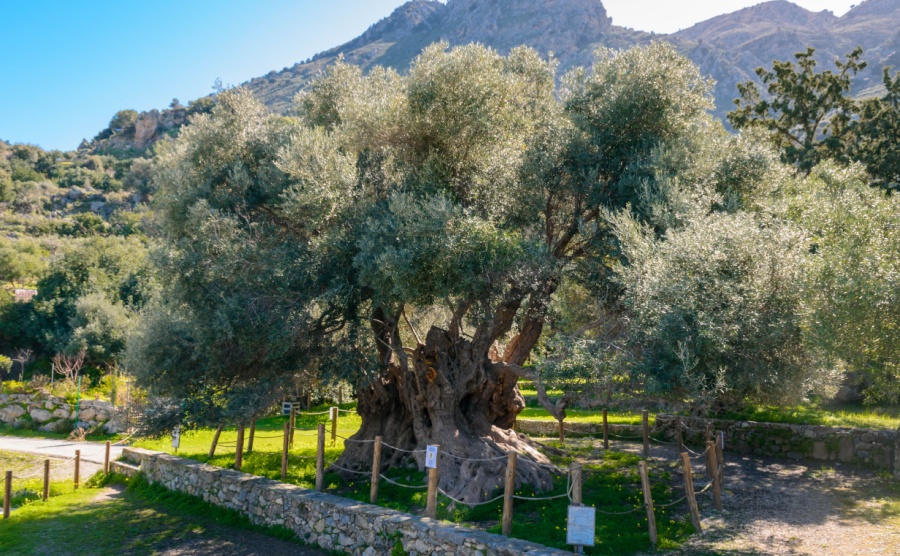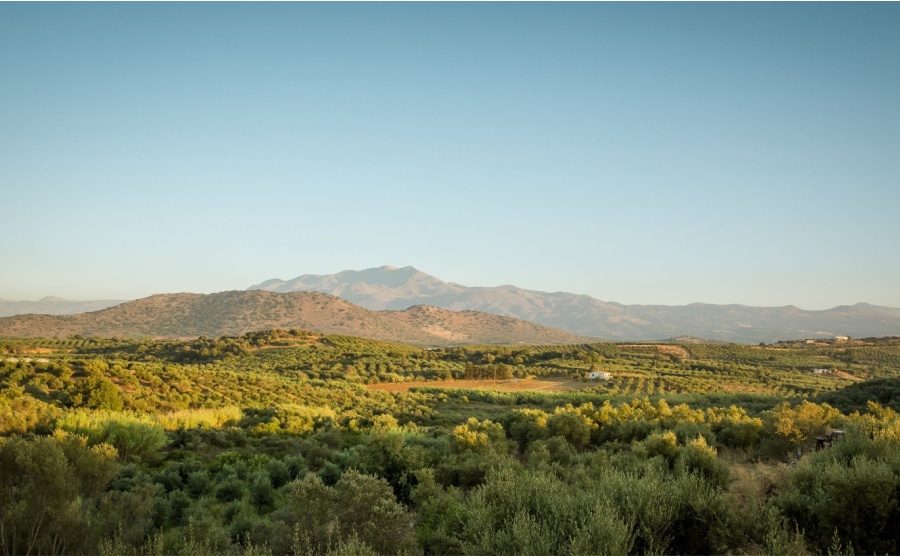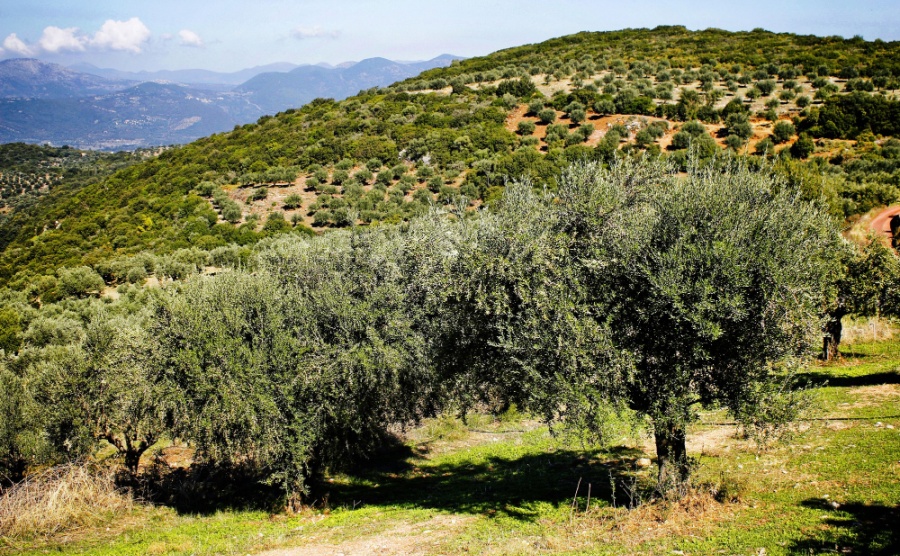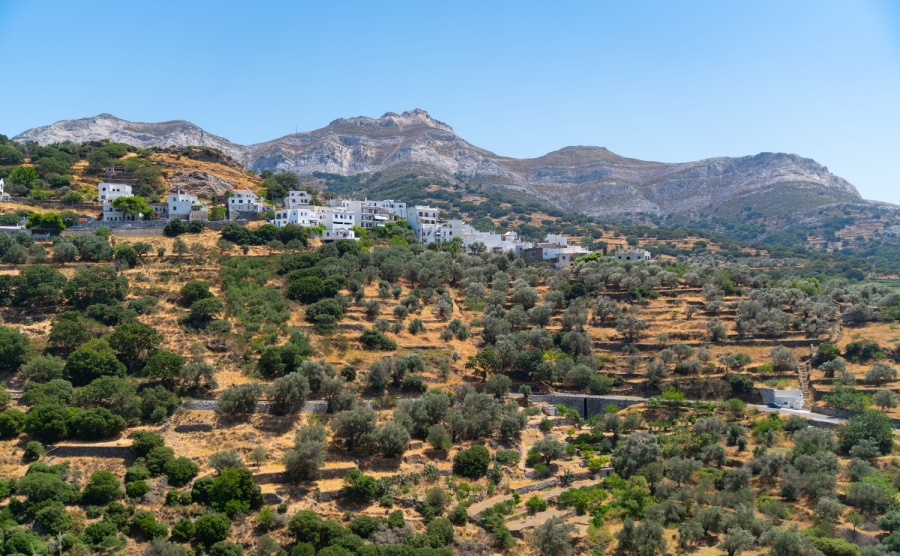Have you been dreaming of escaping modernity to retreat to rural Greece? How would you like to experience a taste of authentic Greek culture and own a home with an olive grove? Properties with olive groves are historic, beautiful, delicious and potential money makers. We delve into the practicalities.
In Greece, you can buy property and land with an olive grove, and experience the thrill of tasting olive oil from your own trees. For many Greeks caring for the old olive trees, that have been passed down through the family, is an important part of their culture. Ever since the ancient Greeks began pressing olives more than 5,000 years ago, the quality of oil produced in Greece has been considered among the best in the world.
Find homes in Greece via our property portal.
Oldest olive tree
In a village called Ano Vouves, on the island of Crete there is an olive tree with a massive gnarled and twisty trunk. This tree is thought to be between 2,000 and 4,000 years old, and is therefore considered the oldest monumental olive tree in the world. It is so treasured, cuttings from this very tree were made into olive wreaths (kotinos) and awarded to the winners in the 2004 Athens Olympics.
It is amazing to visit a natural monument of such a grand old age, and imagine the number of olive pickers it has seen come and go over the centuries. Each one, passing down harvesting techniques to their children.
However, many young Greeks now seek higher paid employment in the cities and seaside resorts, and decide to sell the land they have inherited. Some of these plots are in locations close to roads and amenities and have gained permission to build.
Picking olives
Although small olive farmers don’t make a fortune selling olive oil, they do save their families money, by sharing the oil with them. If they are fortunate to have some family living locally, they usually all help with the picking. However, hand picking is very hard work, and you do need to pick a lot of olives to get enough to produce oil.
Considering how little the olives can be sold for at the press, it isn’t really viable to pay pickers. However, you might find locals willing to pick your olives if they can keep the oil. You can also negotiate a quantity for your own use.
Olive oil tourism
To supplement their income, some olive farms offer holiday accommodation or even tours of their olive grove. In fact, Greece is considered the third-best country in the world for olive oil tourism, after Spain and Italy. When viewing property with an olive grove, you may find it useful to go on an olive grove tour or stay at a countryside property with an olive grove.
Olive oil tourism, also known as “oleotourism”, has certainly been growing in popularity. Farms and olive presses, offer tasting sessions and tours. They may even offer a traditional Greek lunch. 60% of Greece’s land is dedicated to olive oil production, with groves offering tours throughout mainland Greece and on the most popular islands.
The country is highly regarded for its rich olive oil heritage. Out of the ten main olive oil-producing countries that offer oleotourism, Greece recorded the second highest number of olive oil tasting sessions (65) and the fourth highest ranking in terms of olive oil quality (67).
Olive oil production
In Greece, the production of olive oil in the 2023 /2024 season was around 160K tons, which was lower than usual. Everyone’s olive trees go through cycles of low yielding years. However, they do tend to be followed by a good year.
Greek olive oil production is expected to be moderate to good this year. According to forecasts by the president of the National Interprofessional Olive Oil Organization, production is anticipated to range between 250,000 and 280,000 tons this coming season.
Challenges facing olive farmers
Harvest season takes place between October and January. Achieving a good crop in your olive grove depends a lot on the weather at crucial stages of growing. Therefore, it’s important to get a mild period leading up to harvesting. Among the challenges facing Greek farmers are high temperatures and drought. Storms with heavy downpours and strong winds can also knock young olives off the tree.
Pricing
Producer prices for extra virgin olive oil, have been going down. At one point in the last year they were at €9.50 per kilogram, but within a few months it was down to €7 euros per kilogram. Whether the lower prices will be passed on to the supermarket shelves is yet to be seen. In August 2024, a one litre bottle of olive oil in the biggest supermarket chain in Greece, “Sklavenitis”, was priced at €10.90. At that time a litre bottle in Tesco’s supermarket in England cost €18.89 (£16.00). Buying local olive oil in Greece will be even cheaper.
Award winning olive oil
Despite last years disappointing harvest it didn’t stop the country’s olive growers and presses from producing some of the world’s best extra virgin olive oil. Incredibly, Greek producers won 56 awards (26 Gold and 30 Silver) at the 2024 NYIOOC World Olive Oil Competition.
Where olive trees are grown
The Aegean island of Crete is the largest producing region, responsible for about one-third of the country’s olive oil output. While, the Peloponnese peninsula, is the main producing region on the mainland. However, you will see olives groves across the Greek mainland and its hundreds of inhabited islands. In fact, olive trees are cultivated in 50 out of the 54 municipalities. Of these 16 are PDO olive oil regions and 11 are PGI olive oil regions.
Olive varieties for oil
The most important olive for oil is the “Koroneiki”, especially in Crete and the Peloponnese. Other important varieties grown in the Peloponnese are Manaki, and Athinolia. While on Lesbos they grow Kolovi. But, there are also many more varieties across the country,
What is extra virgin olive oil
Extra virgin olive oil (EVOO) is extracted directly from the olive in a way that preserves its natural flavour. The method of extraction called “cold pressed” ensures the oil keeps it’s flavour, that may otherwise have been lost if it had been exposed to high temperatures.
For extra virgin olive oil, the olives should be pressed within 24 hours of olive harvesting, resulting in a good flavour and aroma. The colour isn’t an indication of quality, it is the acidity level which is important. It should be 0.8% or less, with the best being under 0.3%. A remarkable 80% of all Greek olive oil is extra virgin. There are several categories of Extra Virgin Olive Oil:
Extra Virgin PDO (Protected Designation of Origin).
Extra Virgin PGI (Protected Geographic Indication)
Organic Olive Oil (Grown without any chemical fertilizers or pesticides)
Agourelaio Olive Oil (Early harvest olive Oil)
Table olives
The most famous Greek table olive is Kalamata, (known as Kalamon in Greece), which is found mainly around Messinia in the Peloponnese. In August, a major Greek supermarket were selling Kalamata olives for €0.67 a gram. While in a leading UK supermarket they cost €2.32 (£1.97) a gram. However, 80% of table olives in Greece are actually Conservolia, which are grown throughout Greece. Around Athens they also grow Megaritika.
Crete
When considering buying a property with olive trees, it’s a good idea to go on a tour of an olive grove and press to get an idea what is involved. If you venture into inland Crete, you’ll discover miles and miles of olive groves. Some producers allow tours of their olive presses combined with tasting sessions, and you can usually book a tour from the main seaside resorts. Some of these tours combine a visit to a raki distillery, vineyard or to see honey being produced.
In the international market, olive oil from Crete is well ahead of the other islands. It boasts seven PDO regions as well as one PGI. The Koroneiki variety dominates here, but there are some local varieties such as Tsounati in Chania, Throumbalia in Rethymnon and Hondrolia in Heraklion.
The Olive Festival is organised in Olynthos on the last three days of July. On the last day, there is a concert, and olives are distributed for free. This celebration also aims to remind people about the history of ancient Olynthos.
Browse through properties for sale in Crete here.
Peloponnese
The Peloponnese is a largely rural region, and many households here own olive groves. Koroneiki olives love the rocky, dry areas of the Peloponnese. In Mani (southern Peloponnese), it produces an aromatic peppery oil. While in Messinia (western Peloponnese), it is pressed with other varieties, such as Manaki and Athinolia, resulting in a lighter oil. Each village has its own farming tradition, from shepherding to orange growing.
Kalamata
Kalamata table olives are well known across the world. From the town of Kalamata it’s possible to go on a tour which visits a local olive farm for a wander through the olive trees and to learn about the different kinds of olives and their cultivation.
Depending on the season, you can also see how the olives are pressed. Tours often include a Greek lunch at a local “taverna” restaurant. The town of Kalamata’s also has a famous outdoor market every Wednesday and Saturday, which is full of mouth-watering local produce, including olives.
Sparta
About an hour’s drive from Kalamata is Sparta. Here you can discover more about the history of olive oil at the “Museum of Olive and Greek Olive Oil”. You will also discover the evolution of the technology used to produce olive oil.
The plain around Sparta is covered with olive groves, orange trees, mulberry, and other trees. There are also preserved ruins from ancient Sparta such as the temples of Artemis Orthia, Chalkioikos of Athena, Apollo Karneios, and a Roman theatre. Plus, an interesting archaeological museum.
Discover properties for sale in the Peloponnese.
Nafplio
Just a few kilometres from Nafplio, in East Peloponnese, there are many olive trees. Here you can visit an authentic olive grove and open-air museum. On an organised tour, you can see how the oil is produced and how it is classified. Of special interest to visitors who have olive trees themselves, is the opportunity to learn how to detect potential defects, and how to use and store the olive oil. There is also a description of the harvest procedure, together with the current process of extraction and modern processing methods.
Naxos, Cyclades
On the island of Naxos you can join in with the Annual Feast of Traditional Olive Oil Extraction, which takes place between late January and early February. Hosted in the village of Damalas, it features traditional local foods, wine and music.
There is thought to be 270,000 olive trees on Naxos, with the majority located in the Tragea valley. In the villages, there are both new and old olive presses that allow visitors to watch the olive oil extraction process.
Explore homes for sale in Naxos.
You might also like:



















